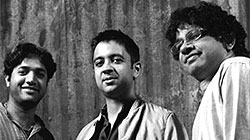|
For many musicians, playing the fearless jazz improvisations of American pianist Thelonious Monk and the undulating rhythmic intricacies of Carnatic music from southern India might seem like an odd combination, but for Indian American jazz pianist Vijay Iyer, it is second nature. When he is not touring the world, Iyer lives with his family in New York, where he records and performs regularly and teaches music to students at New York University, The New School university and the Manhattan School of Music. His 16 albums range from solo piano performances to intricate trio, quartet and quintet interpretations, as well as more unconventional groupings. The 2004 album, “In What Language?” for example, combines jazz influences with hip-hop and a spoken-word performance by poet Mike Ladd, drawing on musical traditions from South Asia and Africa. Iyer says he and Ladd created the song-cycle album as an examination of diversity and tolerance for the post-September 11 world.
Iyer wasn’t always set on being a musician; he holds a master’s degree in physics from Yale College as well as an interdisciplinary doctorate in technology and the arts that he earned at the University of California, Berkeley. Iyer sees an overlap between his scientific background and his musical creativity: He understands the physics behind music and examines the engineering inherent in creating a musical composition.

The Vijay Iyer Trio Photograph by Lynne Harty
|

Nitin Mitta (from left), Vijay Iyer and Prasanna, who formed the group, Tirtha Photograph by Alan Nahigian |

Vijay Iyer Photograph by Hans Speekenbrink |

Photograph by Monique Wuestenhagen |
Prolific and successful as he is, Iyer was not always widely accepted as a pianist or composer. But through a commitment to writing music that melded his influences—Indian and American, especially—Iyer has found a new pathway in American jazz, helping to open the door for new generations of adventurous artists. A new perspective
Iyer was born in Albany, New York, in 1971 and released his first album, “Memorophilia,” in 1995. For many years, jazz listeners and critics didn’t know what to make of his music. In fact, during the first decade of his career, Iyer felt that he was seen as a marginal artist because he and his music were unlike what audiences were used to.
“When people see difference, they can get blinded or deafened by that perception of difference,” Iyer says. “I’m not complaining; that was just my experience. If you’re doing something that’s a little bit against the grain or pushing the envelope or offering something new, then you’re always on the margins of acceptance.” Iyer isn’t the only musician of South Asian descent to break stereotypes and make waves in the world of jazz; frequent Iyer collaborators include saxophonist Rudresh Mahanthappa, guitarist Rez Abbasi, and guitarist Prasanna, who, like Iyer, has been working with Carnatic and jazz music in the United States since the 1990s. “There are also quite a few players around who are a decade or more younger than us,” Iyer says, naming percussionists Sunny Jain, Qasim Naqvi and Ravish Momin; vocalists Sachal Vasandani and Samita Sinha; guitarist Rafiq Bhatia; and trumpeter Suresh Singaratnam. “They’ve all very recently, in the last few years, started to hit their stride.”
He urges other musicians to share their creative work and encourages them to avoid paying much attention to what critics say, negative or positive. “The biggest impact a musician can have is by performing. Reviews are very ephemeral, but the feeling you put into people by being in the same space with them and playing music for them cuts so much deeper.” Global influences and global recognition
By recording and touring for more than a decade, Iyer has earned a growing community of fans around the world. With the release of some of his latest work, he has also earned a stellar reputation in the American jazz community.
His work is no longer seen as a curiosity, but as innovative.
“Stunning. …This is one of the best recordings of the year from one of our most exciting artists,” writes DownBeat magazine of Iyer’s 2009 album, “Historicity.”
An August 2010 Los Angeles Times article states: “If you want to know where jazz is in 2010 and where it’s headed, Iyer is among the first musicians to hear.”
Though critics now herald his work as adventurous, complex and genre-bending, for Iyer, the formula is simple. “I was just…creating based on what I knew, what I’d studied and who I’d studied with,” he says. “That includes pianist Thelonious Monk, who to me is one of the authors of jazz, period. It also includes Carnatic music.”
Iyer keeps a level head about his success. “I’ve been doing a lot of what I want to do,” he says. “I’ve worked hard, made many albums, and some of them have had a pretty big impact, which is more than I expected. It’s opened doors for me. I feel blessed.”
—Courtesy SPAN
|